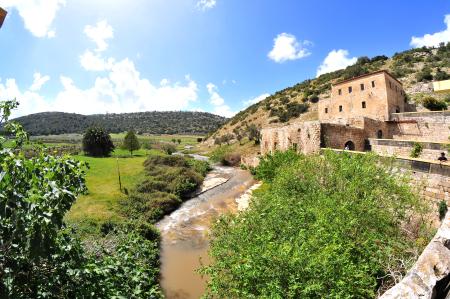
Area characterisation:
The Tzipori stream is located in the river continuum from the hilly Nazareth to Zevulon valley, with a change in land use from mostly rural to urbanized. The regional population is expected to double within the next 30 years. The upper and lower segments of the stream have been modified as flood prevention measures and water is being extracted for agricultural use. The Tzipori River is a perennial Mediterranean river that depends on natural springs, and features diverse aquatic habitats. The basin serves as an important ecological corridor and is characterized by a diverse modern and traditional Arab agriculture, and historical and heritage sites important to the three main religions. It flows through an extensive mosaic of open landscapes and diverse cultural communities and is a refuge for the diminishing wetland habitats and biodiversity.
Objective:
After a decade of restoration measures along the Tzipori stream in Israel, this case study will monitor their success and aims at upscaling measures to the watershed scale in order to create a model for management of stream basin rehabilitation.
This case study is one of 17 that are part of the EU Horizon2020 project MERLIN - Mainstreaming Ecological Restoration of freshwater-related ecosystems in a Landscape context: INnovation, upscaling and transformation.
Potential impacts/benefits:
- Ecological restoration of biodiversity and protected habitats
- groundwater retention
- flood prevention
- increased tourism and recreational value
- educational; a national model for stream restoration
Actions:
- Creation of uphill retention basins
- Soil conservation measures
- Restoration of floodplain habitats
- Improved connectivity: ecological corridors (terrestrial and hydrological)
- Introduction and encouragement of sustainable agricultural land use
- Creation of buffer strips
- Increasing sinuosity and habitat heterogeneity
Organisations:
The Steinhardt Museum of Natural History, Tel Aviv University (TAU), Kishon River and Drainage Authority (KRDA)
Global goals:
-
6. Clean water and sanitation
-
12. Responsible consumption and production
-
13. Climate action
-
14. Life below water
-
15. Life on land
-
17. Partnerships for the goals
NBS goals:
- Restoring ecosystems and their functions
- Developing climate change mitigation
- Developing climate change adaptation
- Multi-functional nature-based watershed management and ecosystem restoration
- Nature-based solutions and the insurance value of ecosystems
- Increasing carbon sequestration through nature-based solutions
NBS benefits:
- Flood peak reduction
- Reduce drought risk
- Reduce flood risk
- Reduce run-off
- Developing climate change mitigation
- Improve connectivity and functionality of green and blue infrastructures
- Increase achievements of biodiversity targets
- Increase quality and quantity of green and blue infrastructures
- Increased cultural richness and biodiversity
- Enhancing sustainable urbanisation
- Improve water quality
- Increase awareness of NBS solution & their effectiveness and co benefits
- Increase population & infrastructures protected by NBS
- Increase stakeholder awareness & knowledge about NBS
- Increase willingness to invest in NBS
- Social learning about location & importance of NBS